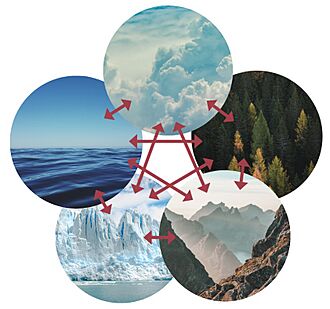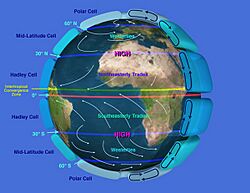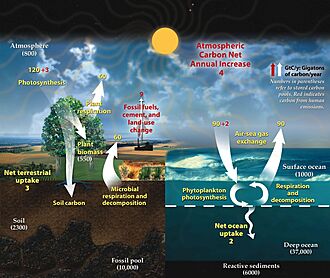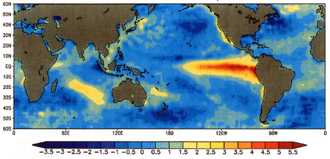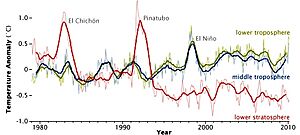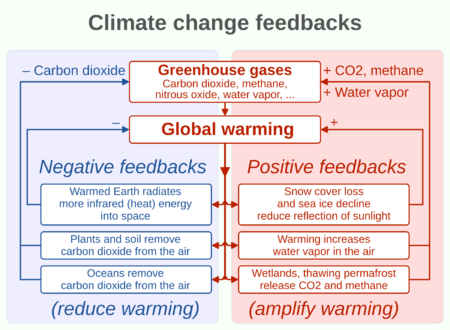Climate system facts for kids
Earth's climate system is a big, connected system made of five main parts that work together: the atmosphere (air), the hydrosphere (water), the cryosphere (ice and frozen ground), the lithosphere (Earth's rocky surface), and the biosphere (all living things).
Climate is not the same as weather. Weather is what's happening outside right now, like if it's rainy or sunny. Climate is the average weather in a place over a long time, usually 30 years. The climate is shaped by things like ocean currents and wind patterns.
The climate system moves heat around the planet. It takes heat from the warm tropical regions near the equator and moves it to colder areas near the poles. The main power source for this is energy from the Sun. The water cycle also helps move energy around. Important chemical elements, like carbon and nitrogen, are also constantly moving between the five parts of the system.
The climate system can change for two main reasons: natural changes from within the system, and "forcings" from the outside. External forcings can be natural, like changes in the sun's energy or big volcanic eruptions. They can also be caused by people. When people burn fossil fuels like coal and oil, they release greenhouse gases into the atmosphere. These gases trap heat and are causing the Earth's climate to change. Human activities also release tiny particles called aerosols that can cool the planet, but their effect is much smaller than the warming from greenhouse gases.
Contents
The Five Parts of the Climate System
The climate system is like a team with five key players. Each one has a special job, but they all interact with each other.
The Atmosphere (Air)
The atmosphere is the blanket of air that surrounds our planet. It's mostly made of nitrogen (78%) and oxygen (21%). But tiny amounts of other gases, called greenhouse gases, are very important for the climate. These gases, like water vapour and carbon dioxide, let sunlight pass through to warm the Earth. But they trap some of the heat that Earth sends back out, which keeps our planet warm enough for life.
The Hydrosphere (Water)
The hydrosphere includes all the liquid water on Earth. Most of it is in the oceans, which cover about 71% of our planet. The oceans are very deep and can hold a huge amount of heat, much more than the atmosphere. Ocean water is salty, but the amount of salt can be different from place to place. Only a small amount of Earth's water (about 2.5%) is freshwater, and most of that is frozen.
The hydrological cycle, or water cycle, is the journey of water through the climate system. It affects where and how much it rains, and it also moves a lot of energy around the globe.
The Cryosphere (Ice)
The cryosphere is all the frozen water on Earth. This includes sea ice on the ocean, huge ice sheets in Greenland and Antarctica, permafrost (frozen ground), and snow. Because there is more land in the Northern Hemisphere, it gets more snow cover. The giant ice sheets are like slow-moving rivers of ice that flow towards the sea.
The Lithosphere (Land)
The Earth's crust, or the land, also plays a role in climate. Big mountain ranges can block wind and change where rain falls. Land near the ocean usually has a milder climate than land far away from it. The position of the continents shapes the oceans, which in turn affects how ocean currents move heat around the world.
The Biosphere (Life)
The biosphere is all of the living things on Earth, from tiny ocean phytoplankton to giant trees. Plants and trees affect the climate by absorbing carbon dioxide. They also influence the water cycle. When plants pull water from the ground, it evaporates from their leaves, putting moisture back into the air. Because humans have had such a large impact on the planet, some scientists consider our activities as a separate part of the system, called the anthroposphere.
How Energy and Water Move Around
The climate system is always moving energy, water, and important elements around the planet to keep everything in balance.
Energy from the Sun
The climate system gets almost all of its energy from the Sun. Earth sends energy back into space in two ways: by reflecting sunlight and by releasing heat. The balance between incoming and outgoing energy is called Earth's energy budget. When more energy comes in than goes out, the planet warms up.
The tropics get more direct sunlight than the poles. This temperature difference creates winds and ocean currents that move heat from the warm equator to the cold poles. As warm air rises and moves toward the poles, it cools and sinks, then flows back to the equator.
Ocean water with more salt is denser (heavier). These differences in density help drive a giant ocean circulation pattern called the thermohaline circulation, which is like a massive conveyor belt moving heat around the world.
The Water Cycle
The water cycle describes how water moves between the Earth's surface and the atmosphere. Sunlight evaporates water from oceans and lakes, and plants release water from their leaves. This water vapor rises, cools, and forms clouds. Then, it falls back to Earth as rain or snow. This cycle doesn't just move water; it also moves a lot of energy. When water evaporates, it absorbs heat, and when it condenses into rain, it releases that heat.
Recycling Earth's Building Blocks
Chemical elements that are essential for life, like carbon, are constantly recycled through the climate system. This is called a biogeochemical cycle.
The carbon cycle is very important for the climate because it controls the amount of two key greenhouse gases: carbon dioxide (CO2) and methane. Plants take in CO2 through photosynthesis. When plants and animals breathe, they release it back into the air. Carbon is also stored in the ocean, in rocks, and in the ground. Volcanoes can release CO2 from inside the Earth.
How and Why the Climate Changes
Climate is always changing, over very long and very short periods. Some changes are natural, while others are caused by outside forces, including humans. A change that lasts for 30 years or more is called a climate change.
Natural Climate Patterns
The climate system has its own natural cycles and patterns. These are called internal climate variability. For example, the El Niño–Southern Oscillation is a pattern in the Pacific Ocean where the water gets warmer or cooler than usual. This can change weather all over the world for a year or two. These natural patterns can cause temperatures to go up or down by moving heat between the deep ocean and the atmosphere.
External Pushes on the Climate
Sometimes, the climate is "pushed" to change by forces outside of its five parts. These are called external forcings.
The Sun and Earth's Orbit
The Sun's energy isn't perfectly constant. It changes slightly over time, including in an 11-year cycle. Over thousands of years, slow changes in Earth's orbit and tilt also change how much sunlight different parts of the planet get. These long-term changes, called Milankovitch cycles, are linked to the coming and going of ice ages.
Greenhouse Gases
Greenhouse gases trap heat in the atmosphere. While this is a natural process, human activities are adding extra greenhouse gases to the air. Burning fossil fuels for energy has released huge amounts of CO2 that was stored underground for millions of years. This is making the Earth's "blanket" of greenhouse gases thicker, which is causing the planet to warm up.
Aerosols and Volcanoes
Aerosols are tiny particles in the air. Some come from natural sources like dust or sea spray. Others come from human activities. Some aerosols reflect sunlight and can cool the climate. Big volcanic eruptions can shoot tons of particles high into the atmosphere. These particles can block sunlight and cool the Earth for a year or two.
Changes to the Land
How people use land can also affect the climate. For example, cutting down a forest changes how much sunlight the ground absorbs. Forests also play a big role in the water cycle, so deforestation can make an area drier.
Chain Reactions in the Climate
When one part of the climate system changes, it can cause other changes, like a row of dominoes falling. These are called feedbacks.
- A positive feedback speeds up the change. For example, as the Earth warms, ice and snow melt. Ice is white and reflects sunlight. When it melts, it reveals darker land or ocean, which absorbs more sunlight. This makes the Earth even warmer, which melts more ice. This is called the Ice–albedo feedback.
- A negative feedback slows down the change. It helps keep the system stable.
The different parts of the climate system react to changes at different speeds. The atmosphere can change in just hours or weeks. But the deep ocean and the giant ice sheets can take hundreds or even thousands of years to fully respond to a change.


